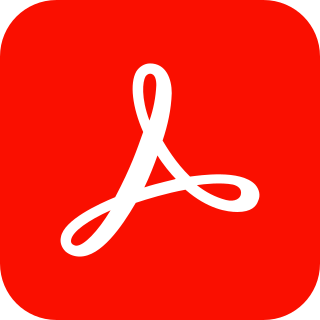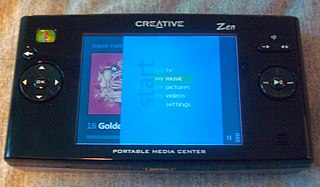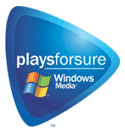
Vorbis is a free and open-source software project headed by the Xiph.Org Foundation. The project produces an audio coding format and software reference encoder/decoder (codec) for lossy audio compression. Vorbis is most commonly used in conjunction with the Ogg container format and it is therefore often referred to as Ogg Vorbis.
Windows Media Audio (WMA) is a series of audio codecs and their corresponding audio coding formats developed by Microsoft. It is a proprietary technology that forms part of the Windows Media framework. WMA consists of four distinct codecs. The original WMA codec, known simply as WMA, was conceived as a competitor to the popular MP3 and RealAudio codecs. WMA Pro, a newer and more advanced codec, supports multichannel and high resolution audio. A lossless codec, WMA Lossless, compresses audio data without loss of audio fidelity. WMA Voice, targeted at voice content, applies compression using a range of low bit rates. Microsoft has also developed a digital container format called Advanced Systems Format to store audio encoded by WMA.

Windows Media Player (WMP) is the first media player and media library application that Microsoft developed to play audio and video on personal computers. It has been a component of the Microsoft Windows operating system, including Windows 9x, Windows NT, Pocket PC, and Windows Mobile. Microsoft also released editions of Windows Media Player for classic Mac OS, Mac OS X, and Solaris, but has since discontinued them. Since 2022, it has been branded with the Legacy suffix to distinguish it from the new UWP-based Media Player introduced in Windows 11.

Adobe Acrobat is a family of application software and Web services developed by Adobe Inc. to view, create, manipulate, print and manage Portable Document Format (PDF) files.
Windows Media Video (WMV) is a series of video codecs and their corresponding video coding formats developed by Microsoft. It is part of the Windows Media framework. WMV consists of three distinct codecs: The original video compression technology known as WMV, was originally designed for Internet streaming applications, as a competitor to RealVideo. The other compression technologies, WMV Screen and WMV Image, cater for specialized content. After standardization by the Society of Motion Picture and Television Engineers (SMPTE), WMV version 9 was adapted for physical-delivery formats such as HD DVD and Blu-ray Disc and became known as VC-1. Microsoft also developed a digital container format called Advanced Systems Format to store video encoded by Windows Media Video.
Shoutcast is a service for streaming media over the internet to media players, using its own cross-platform proprietary software. It allows digital audio content, primarily in MP3 or High-Efficiency Advanced Audio Coding format. The most common use of Shoutcast is for creating or listening to Internet audio broadcasts; however, there are also video streams. The software is available to use for free or as a paid cloud service with additional professional features.

A home theater PC (HTPC) or media center computer is a convergent device that combines some or all the capabilities of a personal computer with a software application that focuses on video, photo, audio playback, and sometimes video recording functionality. Since the mid-2000s, other types of consumer electronics, including game consoles and dedicated media devices, have crossed over to manage video and music content. The term "media center" also refers to specialized application software designed to run on standard personal computers.

Portable Media Center (PMC) is a portable media player (PMP) platform developed by Microsoft. Announced at the 2003 Consumer Electronics Show (CES), and released in early 2004, it was originally positioned as a competitor to Apple's iPod. All its hard drive-based players use a graphical user interface (GUI) modeled after Media Center, a software portal bundled with Windows XP Media Center Edition. Manufacturers of PMC devices included Creative, Philips, iriver, Samsung, and Toshiba.
Digital Living Network Alliance (DLNA) is a set of interoperability standards for sharing home digital media among multimedia devices. It allows users to share or stream stored media files to various certified devices on the same network like PCs, smartphones, TV sets, game consoles, stereo systems, and NASs. DLNA incorporates several existing public standards, including Universal Plug and Play (UPnP) for media management and device discovery and control, wired and wireless networking standards, and widely used digital media formats.

Microsoft PlaysForSure was a certification given by Microsoft to portable devices and content services that had been tested against several hundred compatibility and performance requirements. These requirements include codec support, Digital rights management support, UI responsiveness, device performance, compatibility with Windows Media Player, synchronization performance, and so on. PlaysForSure certification was available for portable media players, network-attached digital media receivers, and media-enabled mobile phones. The PlaysForSure logo was applied to device packaging as well as to online music stores and online video stores.
Neuros Technology was a Chicago, Illinois–based company that produced a number of audio and video devices under the brand name Neuros. Founded by Joe Born in 2001 as a division of Digital Innovations, it previously operated under the name Neuros Audio. Like Digital Innovations, Neuros distinguished itself by its use of open-innovation and crowdsourcing techniques to bring products to market, as well as by its prominent use of open-source software and open-source hardware. In its development model, end users were involved throughout the product development process from reviewing initial concepts to beta testing initial product releases.

A portable media player (PMP) is a portable consumer electronics device capable of storing and playing digital media such as audio, images, and video files. The data is typically stored on a compact disc (CD), Digital Versatile Disc (DVD), Blu-ray Disc (BD), flash memory, microdrive, SD cards or hard drive; most earlier PMPs used physical media, but modern players mostly use flash memory. In contrast, analogue portable audio players play music from non-digital media that use analogue media, such as cassette tapes or vinyl records.
Gapless playback is the uninterrupted playback of consecutive audio tracks, such that relative time distances in the original audio source are preserved over track boundaries on playback. For this to be useful, other artifacts at track boundaries should not be severed either. Gapless playback is common with compact discs, gramophone records, or tapes, but is not always available with other formats that employ compressed digital audio. The absence of gapless playback is a source of annoyance to listeners of music where tracks are meant to segue into each other, such as some classical music, progressive rock, concept albums, electronic music, and live recordings with audience noise between tracks.
Media center or media centre may refer to:

Lyra is a series of MP3 and portable media players (PMP). Initially it was developed and sold by Indianapolis-based Thomson Consumer Electronics Inc., a part of Thomson Multimedia, from 1999 under its RCA brand in the United States and under the Thomson brand in Europe. There were also RCA/Thomson PMPs without the Lyra name, such as the RCA Kazoo (RD1000), RCA Opal and RCA Perl. In January 2008, Thomson sold its Consumer Electronics part including the RCA brand and Lyra line to AudioVox. RCA-branded PMPs are still being made today in its domestic market but no longer under the Lyra name. The Lyra was an early pioneer in digital audio players, although in later years most of its output were OEM products.

Windows Media Center (WMC) is a digital video recorder and media player created by Microsoft. Media Center was first introduced to Windows in 2002 on Windows XP Media Center Edition (MCE). It was included in Home Premium and Ultimate editions of Windows Vista, as well as all editions of Windows 7 except Starter and Home Basic. It was also available on Windows 8 Pro and Windows 8.1 Pro as a paid add-on, before being discontinued in Windows 10, although it can reportedly be unofficially reinstalled using a series of Command Prompt commands.
OpenMG is a digital rights management (DRM) system developed by Sony for managing and protecting digital music data on a personal computer. It was originally designed for audio files in ATRAC3 format; the compliant software, e.g. Sony SonicStage, is usually capable of transcoding MP3 and WAV files to OpenMG/ATRAC3. The file extensions OpenMG-encrypted files use are .omg and .oma.

Zune is a discontinued brand of digital media products and services that was marketed by Microsoft from November 2006 until June 2012. Zune consisted of a line of portable media players, a music subscription service known as Zune Music Pass plus Zune Marketplace for music, TV and movies, streaming services for the Xbox 360 game console, and the Zune software media player for Windows PCs which also acted as desktop sync software for Windows Phone.
A digital copy is a commercially distributed computer file containing a media product such as a film or music album. The term contrasts this computer file with the physical copy with which the digital copy is usually offered as part of a bundle. It allows the disc's purchaser to acquire a single copy of the film on a digital device such as a personal computer, smartphone, tablet computer, or digital media player, and view it on those devices without requiring access to the physical media. "Digital copy" is also commonly referred to as "Digital HD".

Comparisons of media players are lists of digital media player hardware and software products that compare their features. The lists are organized by medium and other characteristics.










